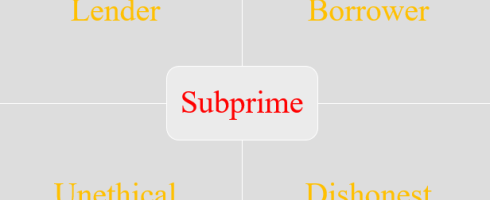The subprime products seemed specially design for targeting vulnerable persons who could not afford loans in general. This effort to sell bad product seemed driven out of greed and unethical behaviour. The lenders appeared to know what they were doing and only seemed more interested in their fees than the impact to the borrowers. The borrowers seemed unaware of what they are very investing in since they were not very unsophisticated investors.
Gilbert, J. (2011) commented that the subprime contracts represented under 20 percent of all home loans owing, but resulted in the dispossessions which spread to other classes of home loans. Organisations within the home loan business laid off a huge number of workers since the fall of 2007 and lost many billions of dollars related to their subprime business. Where did the dominoes start falling? Many people could be at fault for the financial failure. Firstly, it could have begun with the dishonest borrower. Secondly, it could have been the contract specialists who may not have made the correct inquiries before approving the funds. Thirdly, it could be the venture banks who sold investment packages to speculators. Fourthly, the assessment organisations figured out how to transform subprime contracts into prime speculations instruments. Finally, there are the financial specialists who obtained these products without actually comprehending what they were purchasing.
Sternberg (2013) defined the ‘Subprime home loans’ as a blend of credit to buy land and a home loan as security for the advance. In the case of the subprime, that resulted in the crisis the borrowers did not have enough of the components that would support a decent loan. The borrowers of these loans could not own property of sufficient value to reimburse the bank nor were they gainfully employed to support the payment. Some borrowers have no upfront investment in the home they purchased and obtained loans for 100 percent the value of the properties. The borrowers, therefore, are not committed to the investment and would easily walk away from the properties when the situation becomes challenging. This situation created significant exposure to both the borrowers and lenders.
References
Gilbert, J. (2011). Moral duties in business and their societal impacts: The case of the subprime lending mess. Business & Society Review (00453609). Vol. 116 Issue 1, p87-107. 21p. Retrieved from http://proxy1.ncu.edu/login?url=http://search.ebscohost.com/login.aspx?direct=true&db=bth&AN=59161773&site=ehost-live
Sternberg, E. (2013). Ethical Misconduct and the Global Financial Crisis. Economic Affairs. Vol. 33 Issue 1, p18-33. 16p. Retrieved from http://eds.b.ebscohost.com.proxy1.ncu.edu/eds/detail/detail?sid=09de7a34-c59f-4686-892f-2c815dae65a3%40sessionmgr105&vid=0&hid=121&bdata=JnNpdGU9ZWRzLWxpdmU%3d#AN=85317472&db=bth

